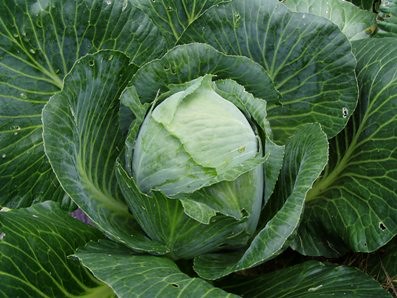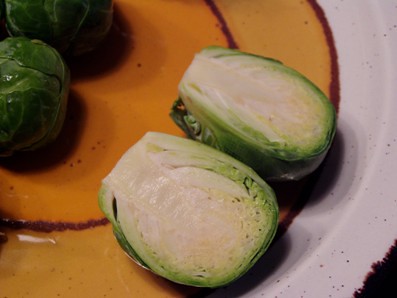 All veggies are good. The more colorful the better. The less cooked, the better (steamed rather than boiled to death). The only problem with veggies, and this happens no matter where you live, is that everything is not available all the time. Nature of the beast.
All veggies are good. The more colorful the better. The less cooked, the better (steamed rather than boiled to death). The only problem with veggies, and this happens no matter where you live, is that everything is not available all the time. Nature of the beast.
What is coming into season now and will be available from now and through to early spring (thanks to refrigerated storage and the process of freezing) is everything from the cabbage family: cabbage(in all its permutations, combinations and theoretical geographic origins: Dutch, German, Chinese, Napa), broccoli, kale, cauliflower, various mustards, and Brussels sprouts.
As Aunt Toby’s readers are definitely aware, I hold a special place in my heart (and digestive system) for members of the cabbage family. I come from an area of the country where cabbage growing (and sauerkraut making) are major activities and I recall many car trips where we saw field upon field of cabbages growing and being harvested. And I also recall my father explaining to me what a great thing it is to have a vegetable that could be grown in a place with such a short growing season and which was sooo good. I swear stuffed cabbage (or, as he called it, halupshis) ran in his veins.
But, back to reality. In 2007, Cornell University researchers issued a report dealing with vegetable growing and consumption in New York State and the rest of the US and the potential for producing more veggies in New York.
Cornell 2007 Veggies Report
This is a fascinating report on a lot of different levels, but what I focused in on was their chart of the top 10 veggies on a consumption base(and this is the same whether you are looking at New York, the Northeast or the rest of the US, in order of rank):
#1: Potatoes
#2: Tomatoes
#3: Head Lettuce
#4: Onions
#5: Carrots
#6: Sweet Corn
#7: Snap Beans
#8: Broccoli
#9: Cucumbers
#10: Green peas
Now, I think all of us can look at this chart and come to some assumptions as to where these figures are coming from:
Potatoes: No matter who, what, when, where, or how – you can find potatoes on the menu everywhere, whether it is home fries for breakfast, French fries at fast food places or potatoes on the menu at dinner. Potatoes are actually a great source of a lot of B vitamins and Vitamin C and fiber, but unfortunately, the way we cook and dress them up tends to put potatoes into a category where people avoid them.
Tomatoes, head lettuce, cucumbers: This, unfortunately, is the basic makeup of almost every salad that people eat, in or out of the home. Perhaps it gets dressed with a bit of grated carrot, but in general, this is a commercial salad.
Carrots, snap beans, peas and sweet corn: Open any freezer compartment in any home and you will pull out bags of this, either singly or in combination (can we say ‘mixed vegetables?’).
Onions: this is one of those basics that, like potatoes, is in every home and is used generally as an ingredient rather than a vegetable on its own. I think the last time ‘creamed baby onions’ was a popular home dinner dish was probably WWII. And that is really too bad because onions have a huge amount going for them in terms of nutritional value, as do all members of the onion family (see garlic).
Broccoli – Why is this vegetable #8???
We are obviously NOT eating enough dark leafy green vegetables, that is for sure. If people think eating head lettuce and cucumbers is the way to go, they are missing something. A little comparison is due on this, I think:
Iceberg Lettuce……………………..Cucumbers………………………..Broccoli
Protein 1.56 grams ………………….2.47 gr……………………………..4.66 gr.
Fiber 0.7 grams ………………………..83 gr………………………………4.68 gr.
Calcium 51 mg. …………………………………………………………………74.72 mg.
Phosphorus 41 mg. ……………………………………………………………140.78 mg.
Iron 1.5 mg. ……………………………………………………………………….1.37 mg.
Vitamin A 0.1 mg. ……………………223.6 mg………………………….2280.72 mg.
Vitamin C 14 mg………………………..5.58 mg…………………………123.4 mg.
Plus Broccoli and all other members of the cabbage family are rated ‘excellent’ sources of vitamins and minerals such as:
folate
manganese
tryptophan
potassium
vitamin B6
vitamin B2
phosphorus
magnesium
omega 3 fatty acids
vitamin B5
vitamin B1 (thiamin)
vitamin B3 (niacin)
zinc
vitamin E
Research over the past ten years into inflammation and cancer has shown conclusively that vegetables from the cabbage family (especially Brussels sprouts and broccoli) contain substances that do three things: dampen inflammatory response in the body, increase the body’s ability to kill tumor cells, and depress the ability of tumor cells to multiply. Brussels Sprouts Nutritional and Health Info
Why are we providing ‘stomach share’ to head lettuce and cucumbers?
I know there are people who hold the same opinion as a former president with regard to broccoli. I am not one of them. So, for those folks who want some great ways to serve the cabbage family to YOUR family:
Cabbage Recipes
More Cabbage Recipes
Tyler Florence Cabbage Rolls (he does his sauce ‘sweet and sour’ using sugar – in my father’s family, you use vinegar and raisins)
More Stuffed Cabbage
Here’s a tip on how to get the cabbage leave to soften up the way you want them:
–Take your cabbage and cut off the bottom and remove a good couple of inches of the core – you don’t need that anyway. Remove the outer couple of leaves.
— Take a BIG pot – a dutch oven, big soup pot, etc. Put the cabbage in the bottom of that and cover with water. Put the lid on the pot.
— Bring to a boil and turn down to simmer. Simmer for 10 min. The outer leaves should be soft enough to take off. You want them LIMP. If they aren’t, cover the pot and simmer some more until they are.
— Put filling in and wrap as you go and put into your pan with sauce to finish cooking the rolls. If you try to cook the cabbage long enough so that the inner most leaves are limp, the outer leaves will be mush. So, unravel the first couple of soft leaves; when you get to firmer leaves, cover the pot and simmer some more. This is really a process.
Broccoli – although I do not hold with handing kids a dish of ranch dressing and washed flowerets to try to get them to eat the vegetable, I do have to admit that doing our own version of Wendy’s ™ baked potato with broccoli and cheese sauce got my kids to eat cooked broccoli, like it, and it’s also a good cheap meal.
Ingredients:
Baked potatoes – however you do yours.
Sauce:
Milk – whatever you have in the fridge – 1-2 cups
2-3 table spoons of flour
2-3 table spoons of butter
Block of hard cheese – cheddar, swiss, whatever you have..combinations work too – the amount will be a block about 2 inches x 2 inches x 1 inch, chopped, grated, etc.
Put butter into a shallow pan and heat until melted.
Put in flour and stir around until it has taken up all the butter AND starts to give off a nice, sort of nutty smell. Don’t burn it.
Slowly, in little dribbles, add milk AND stir it around – use a fork or a whisk or something. Spoons will not work for this part. Keep adding until all the milk is used. You are looking for a thickish white sauce.
Add grated cheese and stir around until all melted into the sauce – if it is too thick, add a little bit more milk to thin it a bit. Cover the pan and put at the back of the stove on NO heat.
Broccoli – after you have made the sauce and the potatoes, THEN make the broccoli. I put ½ inch of water in the bottom of a shallow pan and steam mine. Don’t boil it – it should still be nice and a little bit crunchy.
Split the potatoes, put on the broccoli and cover with cheese sauce. Kids LOVE this and it’s a great fast Sunday ‘just got back from skiing/skating/snow forts etc.” sort of meal. Warm, filling, has all the protein, carbs, vitamins and minerals anyone needs.
Brussels Sprouts with Walnuts – there are a lot of different recipes for this.
Food Network Emeril Recipe (this recipe uses butter and calls for the Brussels sprouts to be boiled first)
My recipe (and my son eats these with no complaints, so it must be pretty decent):
Ingredients:
Fresh Brussels sprouts (you could probably do this with frozen ones too, but I have never tried it)
Olive oil for sautéing
Walnuts, coarsely chopped – 1/3 cup
Liquid (whatever you have in the fridge: red or white wine, a little lemon or orange juice, left over veggie cooking liquid, etc.)
A large frying pan with a lid
Prep:
Figure on 5 sprouts for each person. Make sure they are not too big or woody, wash well, and trim off the bottom. Slice vertically in half.
In the bottom of a large frying pan, put enough olive oil so that when you tip it, you have enough to coat the bottom but not enough to really ‘fry’ anything. This will be at least 2-3 tablespoons. Put pan on a medium heat and place the sprouts, cut side down, in the pan. Cover and cook for five minutes. Check and see if they are starting to brown – if so, turn the heat down.
Once the sprouts have started to brown, put in a little liquid – ¼ cup should be enough – and recover for five more minutes.
If there is still liquid, let that boil off.
Add walnuts, cover so that they are warmed through and serve.
As the Sainted Julia always said, “Bon Appetit!”
(brussels sprouts on stalks photo courtesy of h-bomb)
